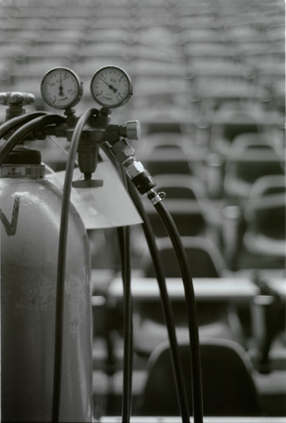Developments in research and teaching
The Faculty of Science has benefited in recent years from a continued and steadily increasing interest in scientific questions, as reflected in the constant expansion of the faculty and growing student numbers. At the same time, the disciplines have developed innovative structures allowing them to maintain their important role within the university.
One of the key foundations for the faculty’s development during the second half of the twentieth century was the establishment of the Biozentrum (Center for Molecular Life Sciences) in 1971. The goal at the time – to unite the various biological and scientific areas under one roof and thus facilitate collaboration among scientists from different research fields – blazed a path later followed by many similar projects. Unique to Basel was that this form of cooperation did not remain limited to the realm of university research but was also actively integrated into teaching, particularly in the degree program developed at the center, Biology II. Its driving ideas, including close ties to a research environment, have been partly preserved in the bachelor's and master's degree programs despite reforms. One highlight in the center’s history has been the Nobel Prize in Medicine/Physiology in 1978 awarded to Werner Arber for the discovery of restriction enzymes and their application in molecular genetics.
Today, the work at the center is structured through the interplay of focal areas and core programs. The methods developed in the core programs (structural biology and biophysics; genome scale biology and bioinformatics) are mobilized and applied in the focal areas (growth and development, infection biology, neurobiology). In addition, the center offers various service facilities, including the Center for Microscopy at the University of Basel (ZMB).
The computer era begins
Another former division of the center, now indispensable to the entire university, is the University Computing Center (Universitätsrechenzentrum, or URZ). As the last Swiss university to do so, Basel acquired its own unit for computer services in 1974, operating university-wide as a service institute, though a large part of the computing services needed for the natural sciences was supplied by the Sandoz company’s mainframe computer at “favorable rates.” Over time, user courses were offered, initially organized independently. In terms of the curriculum for computer science in the true sense of the term, Basel lagged behind other universities, evident in the fact that it lacked a dedicated chair in the field. This “deficiency” was rectified in 1985 with the government’s decision to create an Institute for Computer Science. In 2002, with funds from the Moritz Straus Foundation, the Voluntary Academic Society, and the renewal fund, the institute became the Department of Computer Science. By 2010, the department comprised five professorships with over thirty staff members, while the URZ had evolved in tandem into a central consulting and competence center, serving some 16,000 users.
Nanoscience
Another key area of work within the Faculty of Science is nanoscience. Basel’s Department of Physics was quick to embrace the use of scanning tunneling microscopy, developed since 1981, which made it possible to imprint nanometer-sized structures on surfaces and thus study phenomena at the nano scale. This shift in focus solidified in the 1990s. In 2000, the decision was made in Switzerland to establish a National Centre of Competence in Research (or NCCR) in nanoscience in Basel; the area has since developed into a research focus at the university. In 2002, an interdisciplinary bachelor’s and master’s program in nanoscience was introduced, incorporating courses from physics, chemistry, and biology. In 2006, the Swiss Nanoscience Institute (SNI) was founded, financially supported in part by the canton of Aargau. As of 2010, about 200 employees worked in six focal areas. Similar to the center, interdisciplinary collaboration is at the heart of nanoscience.
New structures
The Faculty of Science’s organizational structure has fundamentally changed over the last fifty years, evincing trends opposite to those at the beginning of the last century. The shift is less toward differentiation and more toward reintegration or reconvergence, as can be exemplified by the development of today’s Department of Chemistry in the 1980s. At the beginning of the decade, chemistry was taught at four different and independent institutes: the Institute for Inorganic Chemistry, the Institute for Organic Chemistry, the Institute for Physical Chemistry, and the Institute for Color Chemistry. The Provisional Division of Chemistry was subsequently founded as a pilot project modeled after English and American departments. Various personnel changes eventually resulted in a new, permanent structure, transforming the Provisional Division of Chemistry into the Department of Chemistry in 1989.
Special forms of cooperation are found in the Department of Environmental Sciences and the Swiss Tropical and Public Health Institute. The Department of Environmental Sciences is home to both the program Mankind- Society-Environment (MUG), now offering a master’s degree in sustainable development, and the Institute for Conservation Biology. Both areas were established in response to the environmental disaster at Schweizerhalle in the 1980s. Among the most recent developments is the integration of the Institute for Social and Preventive Medicine into the Swiss Tropical Institute, which has been operating under the new name Swiss Tropical and Public Health Institute since 2010.



